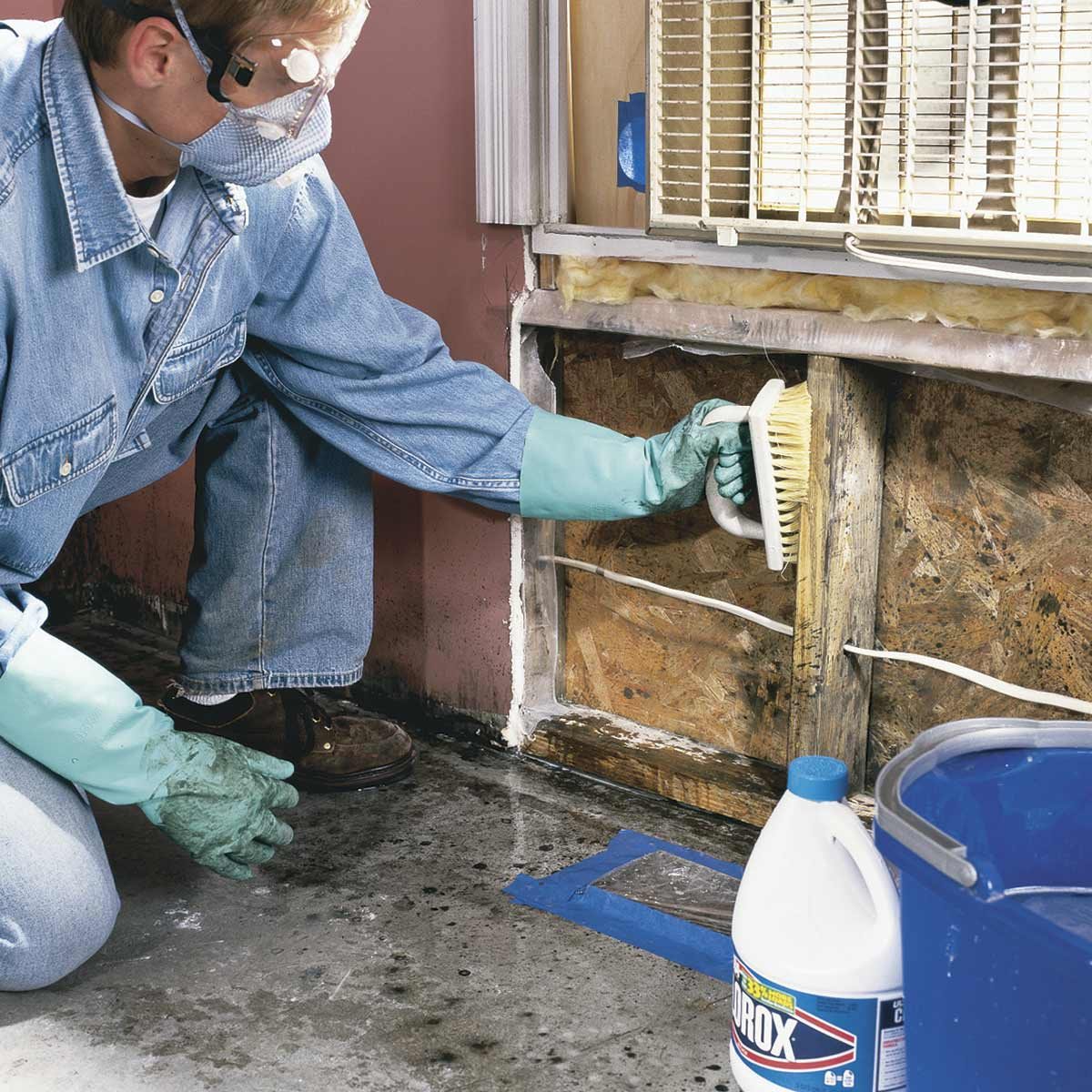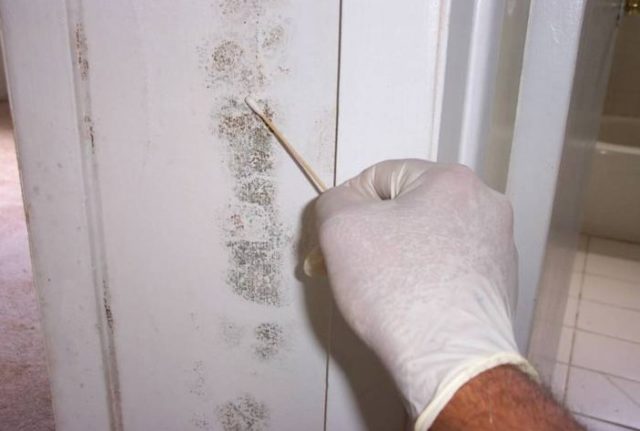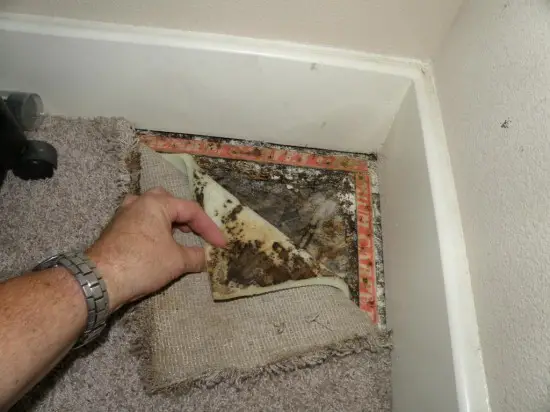Create A Bleach Mixture
If the black mold growth in your home is small enough for you to treat alone, a simple mixture of bleach and water can help. Add one cup of bleach to one gallon of water and apply it to the moldy spots. You can also find commercial black mold removal products.
Soak a paper towel in the cleaner and press it over the mold growth to dampen the area. Then start scrubbing. Avoid spraying moldy areas, since the droplets will collide with the mold spores and launch them throughout the room, making them easier to breathe in and harder to eradicate.
Be sure to dry the area thoroughly when youre done.
Do NOT mix bleach with ammonia. This combination can create toxic fumes that are far more dangerous than any mold youre trying to clean.
Identifying Mold In Your Home
- Appearance or dark spots or clusters. Look for spots or clustered growths, especially in warm, moist rooms.
- Musty smell. You may be able to identify mold by a musty smell.
- Allergies or asthma. If you experience asthma attacks or allergy symptoms in your home, that may also indicate theres mold.
- Potential causes. Look for causes of mold growth, like a leak, water damage, lack of ventilation, or old food, papers, or wood.
How To Test For Toxic Mold
If you have mold in your home, your nose is one of the most inexpensive devises you can use to detect it. Mold smells, and chances are, you’ll be able to detect the distinctive odor that taints the air around moldy walls, carpeting and other objects. The struggle is in understanding when mold is dangerous to your family or home.
The term toxic mold is a little confusing. Some molds, like Stachybotrys chartarum or black mold, produce mycotoxins, toxic substances that cause health problems in some people. There is no direct link yet between mold-produced toxins and serious conditions like idiopathic pulmonary hemorrhage in infants, but there are concerns that exposure to these toxins can exacerbate existing lung conditions and allergies, and possibly cause problems in otherwise healthy people. Common molds that aren’t considered toxic also have the potential to cause reactions in some people, which makes it important to get rid of any type of mold you find in your home as soon as possible, particularly if you suspect that someone in your family is having a reaction to it.
Mold can be scary. There are potential health implications for your family, and a mold outbreak can take a financial toll, too. Once established, mold can be very invasive, releasing millions of spores into your home. Many homeowners’ insurance policies now exclude or limit coverage for mold related problems.
First up, let’s learn a little more about household mold.
Don’t Miss: Mold Or Mildew On Bathroom Ceiling
Black Mold Removal And Cleaning
Mold remediation in stores, offices, or schools is best left to the pros. This also applies to household mold exceeding 10 square feet.
The contractors you choose should have insurance and licenses from organizations like the Institute of Inspection Cleaning and Restoration Certification .
Homeowners can handle cleaning about 10 square feet of black mold on their own.3 If the patch is small enough, a combination of bleach, water, scrubbing, and ventilation should do the trick.
Before treating mold on your own, prioritize ventilation and protective gear.
Removing black mold is a tough and dirty job. If you or anyone in your family is sensitive to mold allergies, has respiratory or immune issues, trust the professionals.
Find a contractor in your area to get started.
Your Planter Of Begonias Is Leaking

Exterior landscaping that is close to the home, as well as planters placed against exterior walls, can also lead to mold issues, especially for stucco homes, says Gregg Cantor, President and CEO of Murray Lampert Design, Build, Remodel. Moisture finds its way inside the walls and can cause mold growth in the drywall and insulation. This type of mold growth can be particularly dangerous because its rarely caught until the mold shows up on the interior of the wall, at which point the growth can be extensive and a danger to your health, says Cantor.
Read Also: Remove Mold On Bathroom Ceiling
What Are The Signs And Symptoms Of Having Mold In Your House
Whether youre selling a home, preparing to buy one for the first time, or just performing regular maintenance, the issue of mold may worry you particularly if your home is in a damp environment.
In most cases, a typical home inspection wont include mold inspections and testing. You will need to hire a professional mold inspector to check your home for issues like black mold.
So, to help you understand whether or not you may need a home inspection for mold, weve put together this comprehensive guide that will help you understand the signs and symptoms of mold, know what next steps to take if you think you have mold issues, and provide you with other helpful information and tips that will help you deal with a potential mold problem.
What To Do If You Have Mold In Your Home
What should you do if you see mold in your home? The first thing is to do some investigation. Mold is a sign of excess moisture. You need to determine the source of moisture and control or eliminate it. Moisture can come from many sources, including leaks, condensation, and ground water. Once you determine the source, take measures to correct the problem.
The Minnesota Department of Health created a fact sheet explaining why it does not support mold testing as a first response to indoor air quality problems. For more information about MDH’s stance on testing, visit Testing for Mold.
Read Also: How To Clean Mold Off Bathroom Ceiling With Vinegar
Where Is Mold Found
Mold is found all over the world. It can grow on and in buildings and also outdoors. Although mold can exist in a variety of places, it grows especially well in damp, moist environments. Your walls, furniture, floors, carpets, and other areas of your home can contain mold. Kitchens, bathrooms, and other damp places are especially likely to have mold. Mold is common everywhere, and people are exposed to it every day.
Dont Miss: Mold In Water Filter
Examine The Mold Visually
The first step in identifying black mold is to examine it visually. Black mold has a distinct look. As the name implies, it is black in color. This makes it unique from other mold types, which are typically brown or green in color. With a distinct color, black mold is pretty easily recognized around the home.
However, the challenge is that black mold often lurks in areas of the home that are not often visited. You should conduct a thorough examination of your home including crawlspaces, cabinets, and other areas you dont often spend time in. This gives you your best chance of identifying black mold, if it exists in your home.
Also Check: How To Clean Mold Off Bathroom Ceiling
Read Also: Removing Mold From Bathroom Ceiling
In The Shower And Bathtub
Showers and bathtubs are one of the most common places you may find mold. With repeated use, these areas tend to be damp most of the time. If you arent properly ventilating during and after your shower or bath, mold spores will thrive. But mold isnt always visible and obvious be sure to check for mold on your shampoo bottles, washcloths and loofahs, shower curtain, in and around the faucet and shower head, and in the tile grout.
Can You Get Sick From Mold In Your House
Yes. Those will allergies, compromised immune systems, asthma, or other such issues are at a higher risk as even minor, non-toxic molds could cause a variety of uncomfortable symptoms. Mold in your house is rarely life-threatening. However, prolonged exposure is far from ideal for a number of reasons.
Don’t Miss: Bathroom Ceiling Mold Removal
Common Places For Mold To Grow
If you have had water damage to your home, its important to be on the lookout for possible mold growth. For example, mold in basement walls or floors can occur after flooding or severe water damage. Also chronic or persistent leaking from appliances, sinks, and showers can also lead to mold growth.
To find hidden mold, look for evidence of water intrusion which is often a sure sign that you either have mold in the home now or will be growing it soon. While it can be difficult to detect mold in the walls, its important to look for these signs of mold growth, to identify the problem as quickly as possible. Moisture meters and particle counters can be used by a certified inspector to source the water leak and fungal growth and even help detect if there is mold in your walls.
If you suspect mold growth in your home, here are some of the most common locations to check for mold to grow in the house:
- Basements
- Air Ducts
- Near Plumbing
Keep in mind that mold is a sign of excessive moisture and water intrusion and can be visible or hidden behind many different surfaces. Whether its from a leaking pipe or previous water damage, mold can lead to costly building repairs and even adverse health effects, which is why it should be handled promptly.
Why Is Black Mold So Dangerous

Black mold is commonly referred to as toxic mold, and for good reason. Aside from causing all kinds of respiratory reactions like coughing, sneezing, sore and itchy throats, and watery and itchy eyes, prolonged exposure can have serious health consequences.Black mold is toxic, and prolonged exposure can have serious health consequences.
One study found that exposure to mold during infancy led to asthma at 7 years of age, while others have linked exposure to brain inflammation, behavioral dysfunction, movement disorders, and neurological deterioration.
In short, black mold warrants its reputation as a toxin, and should be treated as soon as its discovered. Below are several signs it may be inhabiting your home.
Recommended Reading: Clean Mold Off Bathroom Ceiling
Clean Black Mold And Get Rid Of It For Good
Once you know how bad your mold problem is , its time to get rid of the problem.
- Clean mold yourself. If your mold problem is small and visible, like caulking around your bathtub, you can get rid of it yourself. You just want to make sure you use the right cleaning solution. Bleach wont kill mold entirely, and as the chlorine in bleach dissipates, the bleach turns into water, which creates the perfect environment for new mold to grow. Cleaning vinegar will kill mold, as will industrial chemicals like Moldex. Always wear a P100 respirator so you dont inhale mold spores while you clean. Goggles are a good idea too, and a full body suit for larger mold infestations.
- Get rid of mold-contaminated items. Clothing, carpet, drapes, caulking, and paper goods like books and files will all absorb mold spores and can cause new mold growth. If theyve been in an area with black mold, get rid of them, or in the case of cloth goods, get them professionally dry-cleaned. Throwing out belongings is a bummer, but its better to be safe than to have to deal with a new mold problem all over again.
- Professional mold remediation. If you have water damage or major mold contamination in hard-to-reach places, hiring a professional is your best bet. Mold remediation can be expensive, but professionals have the tools to find and eliminate all the mold in your entire home.
Testing For Hidden Or Airborne Mold
Don’t Miss: How To Get Mold Off The Ceiling
Final Word On Black Mold: Best Avoidedbut Not Deadly
As for black molds toxic reputation, those with immune suppression, asthma, or other respiratory problems are most at risk of feeling ill.
Its not likely that youll die from black mold poisoning because its just not that toxic. That said, you should act quickly if you find it in your home. The good news is its treatable, removable, and preventable.
Diy Black Mold Testing
Doctors always say that early detection is the key to effective treatment. This same basic concept should be applied to the issue of black mold. Unfortunately, many people dont know they have black mold in their homes or if they do notice the signs, they simply clean it up and shrug it off. This can have dire consequences. The recent increase in reported cases of black mold has led to a surge in the testing and inspection business. Luckily for consumers, there are two ways to approach this task. The first is the do-it-yourself method and the second is to hire a professional mold testing company near you. We already mentioned the testing and inspection done by an inspector. Lets take a closer look at the DIY method.
You May Like: Remove Mold Bathroom Ceiling
Cleaning Up Small And Medium Mould Problems
Bleach is not necessary to clean up mould.
You can clean up small areas of mould if you follow the proper procedures and use the right protective equipment. Unless the mould growth is on smooth surfaces such as bathroom tiles, surface cleaning will not eliminate the problem.
In most cases you can clean up medium areas of mould if you follow the proper procedures and use the right protective equipment. Materials damaged by mould must be physically removed and disposed of under safe conditions. However, it is important to seek professional assistance if there is a large mould problem or if mould comes back after cleaning.
Susceptible individuals such as pregnant women, infants, children, the elderly, and occupants with asthma, allergies or other health problems should not be in or near the area where the mould is being cleaned up.
Minimum protective gear needed:
- a disposable N95 mask and
- household disposable gloves.
You can purchase an N95 mask from a hardware store. Make sure that the label says N95. Other masks are designed to provide limited protection against dust and are not suitable for protecting against mould exposure. Make sure that the mask is properly fitted and you can breathe through the mask.
You May Like: How To Install Vinyl Stair Treads
Dont Want To Use Chemicals Heres How To Test For Mold In Your Home Naturally
If youre concerned about the effects of harmful chemicals when testing for mold in the house, worry not. Testing for mold doesnt use any chemicals, and kits are non-toxic.
In fact, the main thing you should be worried about when testing for mold is the mold itself. If you are collecting direct samples of mold using the swab technique, wear gloves and a mask to reduce your exposure to the mold.
You May Like: How To Remove Mold On Bathroom Ceiling
Looking For Signs Of Mold In Your Home
Mold can occur anywhere it finds a damp location where it can feed upon the organic components in your building materials. When looking for mold in your home, its important to keep an eye out as well as a nose out for possible signs. Often times mold can hide behind furniture or appliances, making it more likely for you to smell the mold than see it for the first time.
Black mold will have a strong earthy, dirty, and musty smell and is the laymans term used for Stachybotrys mold. This type of mold can have a particularly strong smell making it more noticeable when starting to form. Unfortunately, mold only needs water, organic matter, a dark environment, and time to grow, meaning its often found in places that arent heavily trafficked in the home.
RELATED:Everything You Need to Know About Household Mold
What Is A Mycotoxin Test

Have you been suffering from new allergies, headaches, or other health problems? If so, you may have been exposed to mold. Fortunately, theres an easy, safe way to determine whether youre suffering from the harmful effects of toxic mold. At The Metabolic Institute in Spokane, WA, we offer a specialized mycotoxin test that may determine whether you have mold toxicity in your body. Read on to learn more about how this powerful testing method can help you address the damaging effects of toxic mold exposure.
Read Also: Removing Mould From Bathroom Ceiling
Read Also: Mildew Bathroom Ceiling
